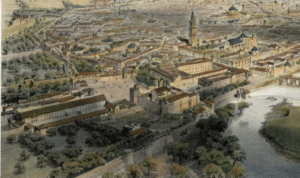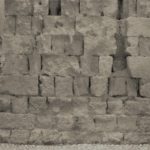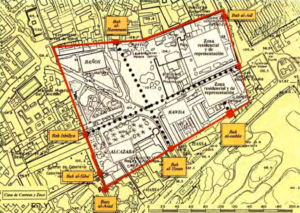
The andalusi Alcazar

The Andalusian Alcazar of Cordoba, the former palace of the Visigoth governor, was the centre of political, religious and economic power of al-Andalus between the first decades of the 8th century and the fall of the Cordovan Caliphate at the beginning of the 11th century, also in the centuries following a prominent role until the Castilian conquest of the city in 1236.
Its walled enclosure would encompass, broadly speaking, the current Episcopal Palace, on whose base you can see some of its eastern walls and towers, the Seminary of San Pelagio, the former Provincial Library, part of the current Alcazar de los Reyes Cristianos and the Plaza of Campo Santos de los Mártires, where the baths were exhumed.


To the south its main door, the Bab al-Sudda, was opened, and on it there was a kind of roof or viewpoint, from where the monarch could contemplate the military parades and the public executions that were carried out in a large esplanade existing between the palace and the river.
The interior of the Alcazar would be organized as a large mixture of buildings of different chronology and functionality: courtly representative spaces, work offices for the Umayyad bureaucracy,service areas, bathrooms, the famous library of the Caliph al-HakamII, a military citadel, a polo field and different landscaped areas, among which the Rauda, which served as the royal cemetery of this Andalusian dynasty.
The Alcazar of Cordoba continued operating normally after the construction of the palatine city of Madinat al-Zahra, and, in fact, we know important works carried out inside by Abd al-Rahman III and al-Hakam II. In this regard, the construction by al-Hakam II of an elevated sabat or passageway that directly connected the Alcazar with the Mosque, heir to another earlier built by the emir Abd Allah, situated somewhat further north, stands out.
Bibliography
LEÓN MUÑOZ, A.; MURILLO REDONDO, Juan F. (2009): “El complejo civil tardoantiguo de Córdoba y su continuidad en el Alcázar omeya”, Madrider Mitteilungen, 50, pp. 399-432.
MARFIL RUIZ, P. (2004b): “Los baños del alcázar califal de Córdoba. Resultados de la intervención arqueología desarrollada en el año 2000”, en GOMEZ NAVARRO, S. (coord.): El Agua a través de la Historia, Córdoba, pp. 51-75.
MONTEJO CÓRDOBA, A. (2006): “La Rauda del Alcázar de Córdoba”, Anales de Arqueología Cordobesa, 17, vol. 2, pp. 237-256.
MONTEJO, A.; GARRIGUET, J. A. y ZAMORANO, A. (1999): “El Alcázar andalusí de Córdoba y su entorno urbano”, en GARCÍA VERDUGO, P. y ACOSTA, F. (coords.): Córdoba en la Historia. La construcción de la urbe, Córdoba, pp. 163-172.
MURILLO REDONDO, Juan F. et alii (2009-2010): “Investigaciones arqueológicas en la muralla de la Huerta del Alcázar (Córdoba)”, en Anejos de Anales de Arqueología Cordobesa, 2, pp. 183-230.
PIZARRO BERENGENA, G. (2013): “Los Pasadizos Elevados entre la Mezquita y el Alcázar Omeya de Córdoba. Estudio arqueológico de los sabatat”, en Archivo Español de Arqueología, 86, pp. 233-249.

